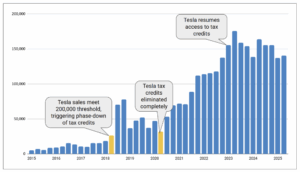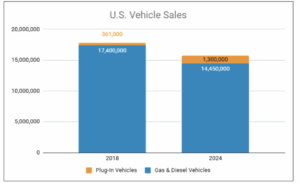The EV tax credits went out with a bang. EV sales for both new and used EVs surged as buyers rushed to take advantage of great deals before the tax credits’ premature end. The prevailing EV sales forecasts anticipate low sales in the fourth quarter of 2025, followed by a gradual increase in sales through 2026. Exactly what this will look like is unclear, but we feel confident that EVs are here to stay. Plug In America has been working for over 16 years to share the wonders of driving electric, and based on our experience, here are 10 reasons why the road ahead is electric.
1. Tax credits are not the strongest drivers of EV adoption.
Plug In America’s EV Driver Survey consistently finds that the single strongest economic driver of EV adoption is access to inexpensive home charging. Additionally, there are numerous examples (Germany/Tesla) of EV sales rebounding after tax credits are eliminated.
For instance, Germany’s EV market continued to grow after a short-term drop in sales. Another example from the U.S. is the prior version of the federal EV tax credit. Until 2022, the federal tax credit was available until a manufacturer sold 200,000 eligible models, after which it was phased out over time. In the graph below, you’ll see that Tesla sales increased once people became aware that access to the $7,500 tax credit was about to end. Sales dropped briefly once the tax credits were gone. The sales drop only lasts for a quarter before sales increase again, demonstrating that policy can increase EV adoption, but losing incentives does not mean the end of EVs.
2. Charging is moving ahead.
EV charging is expanding. Despite the interruption to the National Electric Vehicle Infrastructure (NEVI) program, there has been a steady expansion of EV charging infrastructure being built with private investment. There are now over 230,000 public EV charging ports nationwide. Under pressure from litigation, the NEVI program was restarted. Fifty states and territories have submitted plans so far, and 41 have been approved under the new guidance. Funds are now being released to states to build EV charging stations every 50 miles on interstates across the country. The remaining funds can be used to expand community charging, making it easier than ever to charge wherever you live, shop, work, and play.
3. The used EV market is taking off.
Thanks to the ability to apply the commercial clean vehicle tax credit (45W) to consumer leases, nearly three out of four EV transactions in the last year were leases. Over the next three years, about 1 million EVs are expected to come off leases and enter the used EV market. Used EVs cost about the same as used gas cars, but with much less maintenance and lower operating costs. EVs are gaining a reputation for being durable and reliable, and batteries are lasting much longer than originally expected. Additionally, EVs offer excellent battery and drivetrain warranties of at least 8 years/100,000 miles.
4. The rest of the world is moving forward with EVs.
EV sales are taking off all over the world. While EV market share is growing rapidly in places you might expect, like Europe and China, emerging markets are also embracing EVs. EVs account for over 40% of the market share in Ethiopia, Tajikistan, Djibouti, Sri Lanka, and Nepal. This year, more than one in four cars sold worldwide will be electric.
5. Manufacturers know that EVs are the future.
All of the major automakers currently operating in the U.S. are multinational corporations. Since the rest of the world is clearly transitioning to EVs, they realize that if they don’t step up their electrification game, they will soon be obsolete. That’s why they are joining forces to build a national charging network, offering discounts on EVs to help offset the loss of tax credits, and investing billions in EV platforms.
6. EV innovation continues to improve. Battery prices continue to drop.
The price for an average battery pack has fallen by 50% since 2019. It is expected to continue to fall. Technological innovation enables higher energy density in batteries, and safer, more durable batteries are being featured in an increasing number of vehicles each year. This means that EVs continue to improve and become increasingly affordable.
7. EVs can make electricity less expensive.
Yup, you heard correctly. Since EVs are a mobile, flexible load, they can enable utilities to sell more electricity without the need for costly grid upgrades. A study by Synapse found that EVs contribute much more in utility revenue than costs in all 50 states. During this current affordability crisis, EVs can help make electric rates lower for everyone, not just EV drivers.
8. EVs are replacing gas cars.
Regardless of what you may hear in the media, one fact is clear. Over the last six years, sales of gas cars have declined by approximately six million vehicles, while EV sales have increased by one million. We’ve reached an inflection point. EVs are here to stay because they are simply better vehicles. Hands down, those who try EVs are quickly convinced that they are superior vehicles. If you can charge at home, they are far more convenient. They cost less to own and operate, are fun to drive, and produce zero tailpipe pollution.
9. EV education sells EVs.
Plug In America surveyed thousands of EV drivers and found two key takeaways. First, many of the concerns people have about driving an EV fade away when they switch to an EV. Concerns about cost, range, and battery durability are replaced with confidence once they’ve spent some time in the driver’s seat. The survey also showed that between 2024 and 2025, consumers are becoming more familiar with EVs. The concerns that people sometimes have before driving an EV were less prevalent in 2025, indicating that individuals are feeling more confident about EVs before even purchasing one.
A Consumer Reports survey found that the more direct experience consumers have with EVs, the more likely they are to be interested in buying or leasing one. So, if a consumer has a neighbor or cousin who drives an EV, they are more likely to consider one for themself. With nearly 6 million EVs on U.S.roads today, it’s easier than ever to become familiar with EVs. Be sure to tell your friends and neighbors how much you love your EV.
10. EV drivers love their cars.
Surveys of EV drivers, including the Plug In America EV Driver Survey, McKinsey Annual Mobility Survey, and the Global EV Drivers Alliance Survey, consistently find that at least 9 out of 10 EV drivers love their vehicles and expect their next vehicle to be electric.
In light of the federal policy changes that have shifted support away from clean vehicles, we view this as a speed bump, but not the end of the road. EVs continue to win on their own merits. Once drivers experience the superior driving performance and their fuel and maintenance savings, they breathe easy knowing that the road ahead is electric.


